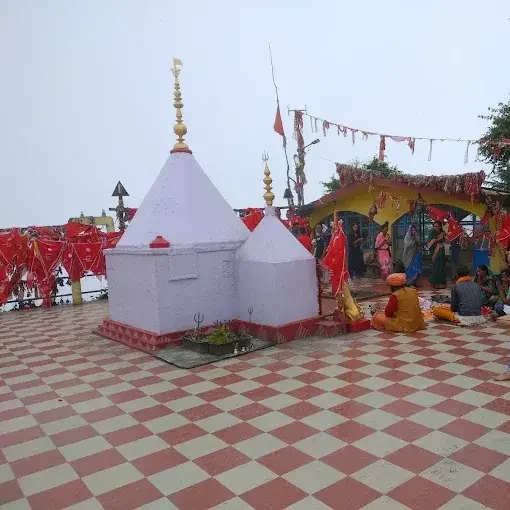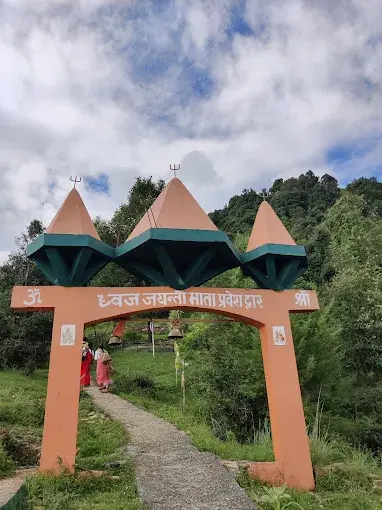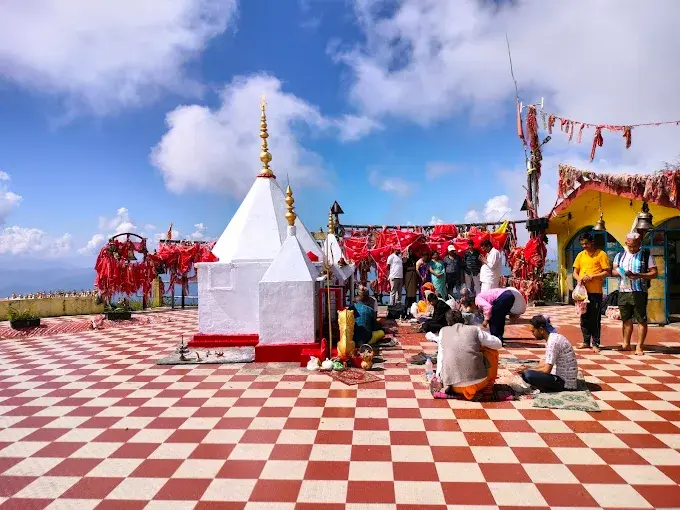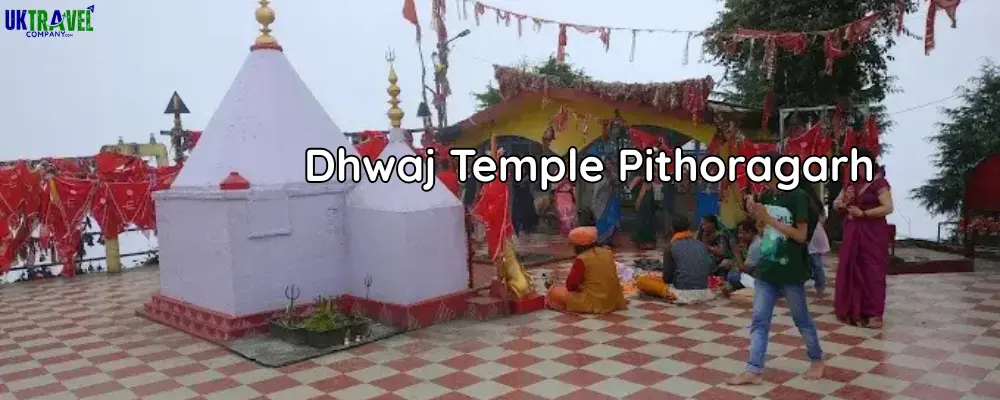Table of Contents
About Dhwaj Temple Pithoragarh – A Sacred Peak with Mesmerizing Views
Perched high in the hills of Pithoragarh, Dhwaj Temple is a peaceful and sacred spot dedicated to Lord Shiva and Goddess Jayanti. Surrounded by stunning views of the Himalayas, including peaks like Nanda Devi and Panchachuli, it’s a perfect escape for nature lovers, spiritual seekers, and trekkers alike. A visit here is truly unforgettable.
Where Did It Come From? (Dhwaj Temple Origins)
The name “Dhwaj” translates to “flag” in Hindi, symbolizing victory, sanctity, and divine presence. According to local beliefs, this hilltop site was blessed by the presence of Lord Shiva and Goddess Jayanti, making it a sacred ground for devotees.
It is said that ancient sages meditated here, and the temple’s location was revealed to them through divine visions. Over time, the site transformed into a powerful spiritual center, drawing pilgrims from across Uttarakhand and beyond.
The History Behind Dhwaj Temple
While there is no documented record of the exact time when Dhwaj Temple was constructed, it is believed to date back several centuries. The temple is rooted in Shaivism—the worship of Lord Shiva and the local Kumaoni traditions.
Ancient oral tales passed down generations speak of this place as a tapobhoomi (place of penance) for sages who meditated amidst nature to seek divine enlightenment. The flag (Dhwaj) that once fluttered high above the peak marked this as a beacon of spirituality and cosmic energy.
During festivals like Mahashivratri and Navratri, thousands of devotees hike their way up to seek blessings, reinforcing the temple’s historic and cultural importance in the region.
Dhwaj Temple Photos and Architecture



Unlike the grand stone-carved temples of the plains, Dhwaj Temple boasts a simplistic and rustic charm, deeply rooted in Himalayan architecture. It is a small stone and wood structure adorned with tridents (trishuls), red flags, and bells, a visual symbol of mountain spirituality.
Key Architectural Highlights:
- Pyramidal stone structure
- Surrounded by trishuls offered by devotees
- Beautifully set amidst dense oak and pine forests
- Panoramic backdrop of Nanda Devi, Nandakot, and Panchachuli
What Makes Dhwaj Temple Unique?
Scenic Trekking Route
One of the most unique aspects of Dhwaj Temple is the 7–8 km scenic trek from Pithoragarh town. The trail meanders through forests, offering sights of Himalayan birds, wildflowers, and pristine air.
Mythological and Energetic Power
Devotees believe that the temple has healing powers, especially for those struggling with health and mental peace. The energy here is often described as “vibrational and calming.”
Eco-Spiritual Harmony
The temple is situated in a zero-pollution zone, making it ideal for meditation, yoga, and silence retreats. Its untouched natural surroundings amplify its spiritual ambiance.
Dual Deity Worship
Worshipping both Lord Shiva and Goddess Jayanti in a single shrine is rare, making Dhwaj Temple a unique confluence of masculine and feminine divine energies.
Location and How to Reach
| Mode | Details |
|---|---|
| Location | Approximately 10 km from Pithoragarh town, at an altitude of around 2,100 meters |
| By Road | Drive from Pithoragarh to Lalku or Totana, the base points for the trek |
| Shared taxis and private cars are easily available | |
| Trek Route | 7–8 km well-marked trek to the temple |
| Takes about 2–3 hours depending on fitness level | |
| By Air | Nearest airport: Naini Saini Airport, Pithoragarh (approximately 10 km away) |
| By Train | Nearest major railway station: Tanakpur Railway Station (about 138 km away) |
| Travel Tip | Start your trek early in the morning to avoid midday heat and enjoy the best views |
Best Time to Visit Dhwaj Temple
The best time to visit Dhwaj Temple is during the spring, summer, and post-monsoon months, when the weather is clear and the trek is most enjoyable.
| Season | Months | Highlights |
|---|---|---|
| Spring | March to April | Pleasant weather, blooming flora, ideal for trekking and photography |
| Summer | May to June | Cool mornings and evenings, clear views of the Himalayan peaks |
| Post-Monsoon | September to November | Fresh greenery after rains, crisp air, and stunning sunrise/sunset vistas |
| Winter | December to February | Trek becomes challenging due to cold and occasional snowfall; not recommended |
Travel Tip
For the clearest mountain views, plan your visit in early morning hours during April, May, or October. Avoid the monsoon season (July to August), as the trail can be slippery and visibility is low.
FAQs About Dhwaj Temple
1. What is the best time to visit Dhwaj Temple?
The best time to visit is from March to June and September to November, when the weather is pleasant and the skies are clear for mountain views.
2. Is the Dhwaj Temple trek difficult?
It is a moderate-level trek, suitable for beginners with basic fitness. The trail is well-trodden and safe.
3. Are there any accommodations near Dhwaj Temple?
There are no accommodations at the temple site itself. Pithoragarh town offers multiple hotels, guest houses, and homestays.
4. Is photography allowed at the Dhwaj temple?
Yes, but it is advisable to avoid flash photography inside the sanctum. The surroundings are perfect for landscape photography.
5. Are there any food stalls in route?
There are a few small stalls at the base and occasionally along the trail, but it’s best to carry water and snacks.
Conclusion
Dhwaj Temple is not just a spiritual journey—it’s a holistic experience that rejuvenates your soul, body, and mind. Surrounded by the mighty Himalayas and echoing with ancient chants and mountain winds, it invites you to disconnect from the chaos and reconnect with the divine.
Whether you seek blessings, peace, or just a perfect trekking destination in Uttarakhand, Dhwaj Temple in Pithoragarh deserves a top spot on your travel list.



